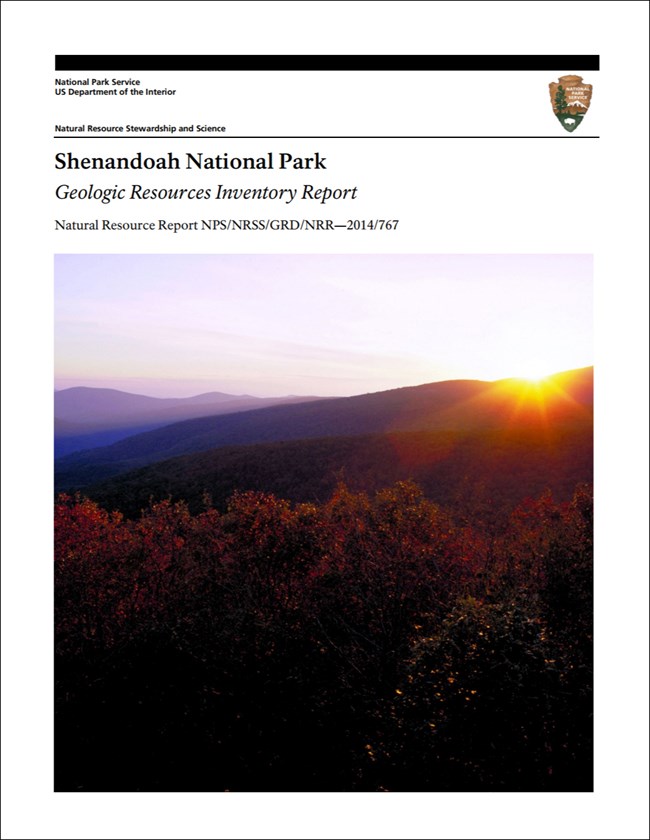Last updated: July 16, 2024
Article
NPS Geodiversity Atlas—Shenandoah National Park, Virginia
Geodiversity refers to the full variety of natural geologic (rocks, minerals, sediments, fossils, landforms, and physical processes) and soil resources and processes that occur in the park. A product of the Geologic Resources Inventory, the NPS Geodiversity Atlas delivers information in support of education, Geoconservation, and integrated management of living (biotic) and non-living (abiotic) components of the ecosystem.

Introduction
Shenandoah National Park (SHEN) is located less than 145 km (90 mi) southwest of Washington, D.C. along the crest of the Blue Ridge Mountains in Albemarle, Augusta, Greene, Madison, Page, Rappahannock, Rockingham, and Warren Counties, Virginia. The park was authorized by Congress on May 22, 1926 to preserve and protect nationally significant natural and cultural resources, scenic beauty, and designated wilderness within Virginia’s northern Blue Ridge Mountains. SHEN encompasses about 80,580 hectares (199,117 acres) of mountains, forests, meadows, and culturally and historically significant areas (National Park Service 2016). An abundant and diverse array of wildlife are found in SHEN, as well as 805 km (500 mi) of hiking trails, including 163 km (101 mi) of the Appalachian Trail. Several historically significant landmarks are preserved in SHEN, including Skyland, Rapidan Camp, and structures built by the Civilian Conservation Corps.
Geologic Setting
Shenandoah National Park showcases the geology and high elevation hydrology of the Appalachian Mountains, one of the oldest mountain ranges on earth. The bedrock geology of SHEN can be subdivided into four main types of rock: (1) Mesoproterozoic metamorphic and igneous rocks that are approximately 1.2–1.0 billion years old; (2) Neoproterozoic metamorphic and igneous rocks that are approximately 800–570 million years old; (3) Paleozoic metamorphosed and non-metamorphosed sedimentary rocks that are approximately 540–420 million years old; and (4) isolated intrusions of Jurassic igneous rocks that are approximately 200–150 million years old (Southworth et al. 2009a, 2010). Structurally, SHEN straddles the Blue Ridge–South Mountain anticlinorium, characterized by steep-sloped topographic highs consisting of resistant Mesoproterozoic gneisses and granites, Neoproterozoic greenstones and metasedimentary rocks, and Cambrian quartzites or sandstones. SHEN offers opportunities to examine the core of an ancient mountain fold-and-thrust belt, providing a view into some of the oldest rocks of the eastern United States (Thornberry-Ehrlich 2014).
Paleontological Resources
All NPS fossil resources are protected under the Paleontological Resources Preservation Act of 2009 (Public Law 111-11, Title VI, Subtitle D; 16 U.S.C. §§ 470aaa - 470aaa-11).
Cave and Karst
All NPS cave resources are protected under the the Federal Cave Resources Protection Act of 1988 (FCRPA)(16 U.S.C. § 4301 et seq.).
Abandoned Mineral Lands
NPS AML sites can be important cultural resources and habitat, but many pose risks to park visitors and wildlife, and degrade water quality, park landscapes, and physical and biological resources. Be safe near AML sites—Stay Out and Stay Alive!
Regional Geology
Shenandoah is a part of the Blue Ridge Physiographic Province and shares its geologic history and some characteristic geologic formations with a region that extends well beyond park boundaries.
- Scoping summaries are records of scoping meetings where NPS staff and local geologists determined the park’s geologic mapping plan and what content should be included in the report.
- Digital geologic maps include files for viewing in GIS software, a guide to using the data, and a document with ancillary map information. Newer products also include data viewable in Google Earth and online map services.
- Reports use the maps to discuss the park’s setting and significance, notable geologic features and processes, geologic resource management issues, and geologic history.
- Posters are a static view of the GIS data in PDF format. Newer posters include aerial imagery or shaded relief and other park information. They are also included with the reports.
- Projects list basic information about the program and all products available for a park.
Source: Data Store Saved Search 3172. To search for additional information, visit the Data Store.
A NPS Soil Resources Inventory project has been completed for Shenandoah National Park and can be found on the NPS Data Store.
Source: Data Store Saved Search 3123. To search for additional information, visit the Data Store.
Related Articles
Shenandoah National Park
National Park Service Geodiversity Atlas
The servicewide Geodiversity Atlas provides information on geoheritage and geodiversity resources and values within the National Park System. This information supports science-based geoconservation and interpretation in the NPS, as well as STEM education in schools, museums, and field camps. The NPS Geologic Resources Division and many parks work with National and International geoconservation communities to ensure that NPS abiotic resources are managed using the highest standards and best practices available.


